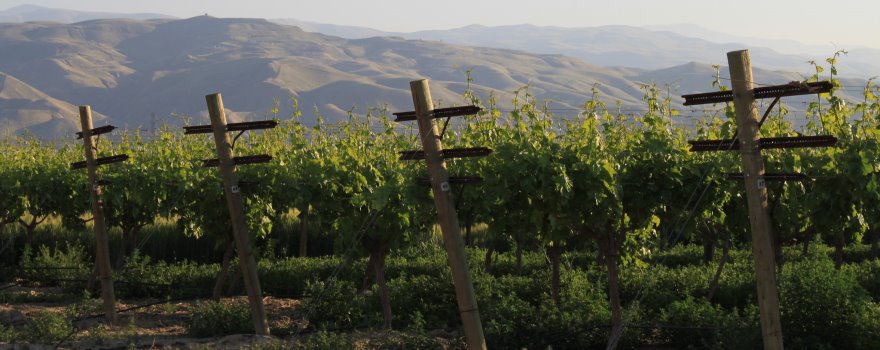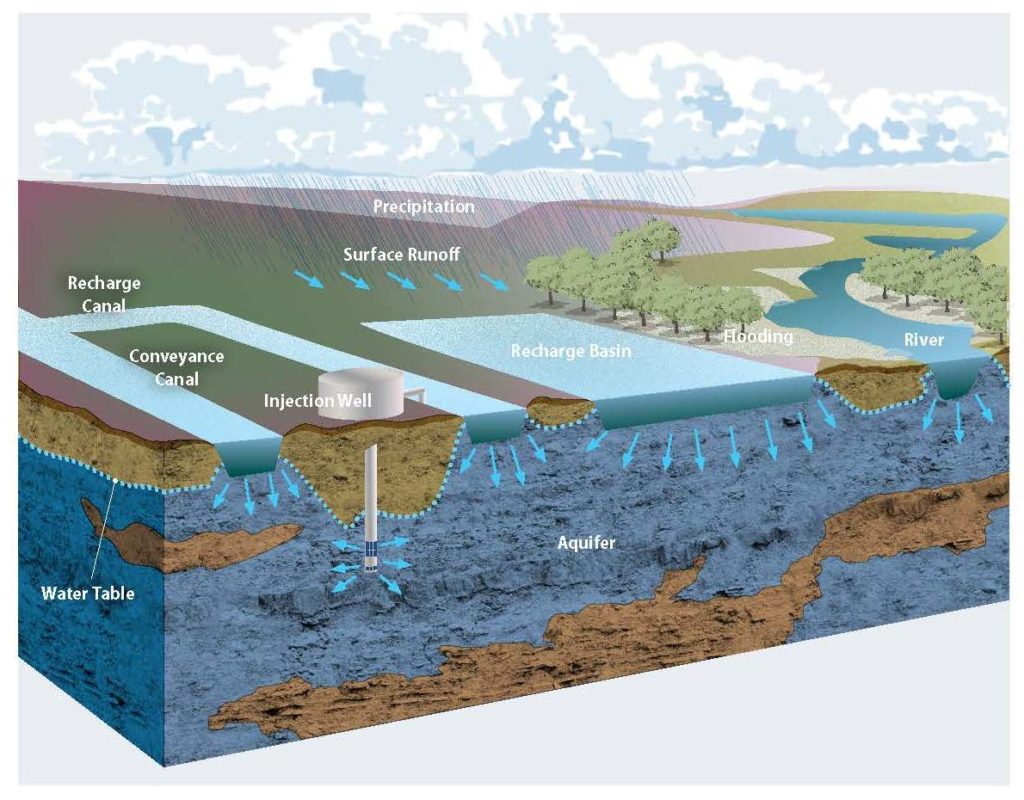 Eric Averett is general manager of the Rosedale-Rio Bravo Water Storage District in Kern County, California, which is one of 21 regions required by the state to balance groundwater demand and supply within 20 years under the Sustainable Groundwater Management Act. Rosedale is home to approximately 27,500 acres of irrigated cropland and 7,500 acres of urban development. Groundwater demand there exceeds supply by approximately 5,000 acre-feet per year. To inform landowners about their water budgets, Rosedale partnered with EDF, Sitka Technology Group, WestWater Research and local landowners to co-develop a new online, open-source water accounting and trading platform. We asked Eric to answer a few questions about how the platform will help local landowners and how it can be expanded to other parts of the Central Valley.
Eric Averett is general manager of the Rosedale-Rio Bravo Water Storage District in Kern County, California, which is one of 21 regions required by the state to balance groundwater demand and supply within 20 years under the Sustainable Groundwater Management Act. Rosedale is home to approximately 27,500 acres of irrigated cropland and 7,500 acres of urban development. Groundwater demand there exceeds supply by approximately 5,000 acre-feet per year. To inform landowners about their water budgets, Rosedale partnered with EDF, Sitka Technology Group, WestWater Research and local landowners to co-develop a new online, open-source water accounting and trading platform. We asked Eric to answer a few questions about how the platform will help local landowners and how it can be expanded to other parts of the Central Valley.
Category: Blogs
How water justice groups view groundwater sustainability planning
Over-pumping of groundwater has caused domestic wells to go dry in the San Joaquin Valley. Yet many of the first round of plans prepared to comply with the Sustainable Groundwater Management Act (SGMA) do not yet propose ways to address this problem. We explored groundwater planning with three members of the environmental justice community—Angela Islas of Self-Help Enterprises, Justine Massey of the Community Water Center, and Amanda Monaco of the Leadership Counsel for Justice and Accountability.
How groundwater managers can avoid the courts as they divvy up water

From the Environmental Defense Fund:
One of the biggest challenges to implementing California’s Sustainable Groundwater Management Act hovers around this two-part question:
Who gets to pump groundwater and how much do they get to pump? Or, put another way, who must cut their groundwater use and by how much?
As local groundwater agencies try to answer this difficult question on how to develop allocations, they face one major constraint: They can’t change groundwater rights.
Consequently, the path forward for many groundwater agencies is riddled with legal complexities and questions around equity that shouldn’t be ignored.
Click here to continue reading this article at the Growing Returns blog.
Successful Integration: How SGMA and IRWM Can Utilize Each Other’s Strengths

Guest commentary from Soua Lee, Program Manager of the Kings Basin Water Authority, on behalf of the IRWM Roundtable of Regions, posted at Maven’s Notebook:
How does a region integrate Sustainable Groundwater Management Act (SGMA), a program mandated by State legislation, with Integrated Regional Water Management (IRWM), a voluntary collaborative effort, to implement regional water management solutions?
A question often asked, but with no definitive answer depending on who you ask. This article discusses how IRWM and SGMA share a similar approach that involves comprehensive management on a regional scale and provides examples of where the two programs are working together successfully.
Click here to read this article.
WEBINAR: Successful collaboration between IRWM and SGMA
This webinar discusses the benefits of successful collaboration between groundwater sustainability agencies implementing the Sustainable Groundwater Management Act (SGMA) and Integrated Regional Water Management (IRWM) planning efforts.
The speakers were:
- David Orth, Principal, New Current Water and Land
- Rob Swartz, Manager of Tech Services, Regional Water Authority and American River IRWM
- Angela Islas, Community Development Specialist, Self-Help Enterprises
The panel was moderated by Lance Eckhart, General Manager of the San Gorgonio Pass Water Agency.
Q&A: Elevating NGOs and Community Groups in Groundwater Decision-Making
From the Water Foundation:
Through the NGO Groundwater Collaborative, non-governmental organizations (NGOs), Tribes, and California residents share information and resources to help each other participate in the state’s groundwater management programs. We spoke with Jennifer Clary, California Director for Clean Water Action California, and Emily Finnegan, Project Manager for Local Government Commission’s water programs, about the collaborative and what’s coming up for the group.
Consultants share their top 10 lessons learned from 5 years of SGMA implementation
“California’s Sustainable Groundwater Management Act (SGMA) is a complex program with a new language that must be mastered by consultants, basin managers, and stakeholders alike. When California first embarked upon the SGMA journey five years ago, there was a lot of trepidation about implementing this bold and untested groundwater management program.
M&A’s SGMA team has worked on 13 Groundwater Sustainability Plans (GSPs), including three GSPs submitted in January 2020. It hasn’t always been easy, and there have been plenty of bumps along the way, but we’ve learned a lot in those five years, and we are happy to share some of what we learned. … ”
Click here to read this article from Montgomery & Associates.
Rebalancing Agricultural and Natural Land
 From Stanford’s Water in the West:
From Stanford’s Water in the West:
“Over the next 20 years, San Joaquin Valley farmers may need to temporarily fallow or permanently retire over half a million acres of cropland as California pushes towards sustainable groundwater use.
But, according to new research led by Stanford University and The Nature Conservancy, using an informed approach to land management that engages and compensates landowners for dedicating land to habitat can spur recovery of biodiversity in local ecosystems and provide other environmental benefits for people.
While California’s San Joaquin Valley produces crops totaling over $35 billion a year on five million acres of land, expanding irrigated agriculture has led to significant challenges such as groundwater overdraft and drinking water contamination, along with major losses of biodiversity and habitat.
Implementation of the Sustainable Groundwater Management Act (SGMA) – which limits groundwater withdrawal to bring water use into balance with supplies in California – provides an opportunity for conservation actors to work with farmers and re-envision the balance between agricultural and natural land. … ”
Click here to continue reading this article from Stanford’s Water in the West.
GSA SUMMIT: Addressing environment, disadvantaged communities, and domestic wells in the 2022 Groundwater Sustainability Plans
 The groundwater sustainability plans that were submitted to the Department of Water Resources in January of 2020 were the first of the groundwater sustainability plans to be completed. Public review of these plans has revealed some important lessons to be learned to be considered for those preparing the plans that will be due in January of 2022. At the 3rd Annual Groundwater Sustainability Agency Summit hosted by the Groundwater Resources Association online in June, a panel of NGOs that had completed a review of the plans summarized their findings from the perspective of underrepresented beneficial users and with respect to stakeholder engagement, providing insights and recommendations for the upcoming plans.
The groundwater sustainability plans that were submitted to the Department of Water Resources in January of 2020 were the first of the groundwater sustainability plans to be completed. Public review of these plans has revealed some important lessons to be learned to be considered for those preparing the plans that will be due in January of 2022. At the 3rd Annual Groundwater Sustainability Agency Summit hosted by the Groundwater Resources Association online in June, a panel of NGOs that had completed a review of the plans summarized their findings from the perspective of underrepresented beneficial users and with respect to stakeholder engagement, providing insights and recommendations for the upcoming plans.
Click here to read this article at Maven’s Notebook.
Water right permitting options for groundwater recharge: Avoiding unintended consequences
“Efforts to boost groundwater recharge are critical to making California’s limited, and increasingly volatile, water resources go further. Recharge is playing a growing role in maintaining groundwater as an effective drought reserve and in slowing or reversing the effects of years of unsustainable groundwater pumping.
But implementing recharge projects is not easy. Water managers face a range of hurdles. Even with the Sustainable Groundwater Management Act (SGMA) on the books, and the increasing availability of technical assistance, local decision makers are left mostly to their own ingenuity to figure out how to shore up groundwater resources to meet future needs.
Many Groundwater Sustainability Agencies (GSAs) expect recharge to help them meet their responsibilities under SGMA. But the details of how they will implement recharge projects are often unclear. … “
Click here to continue reading this article at Legal Planet.
When does a groundwater recharge project NOT need a water right?
“Groundwater recharge projects already play an important role in California. That role is about to expand rapidly, as local groundwater managers begin to take more concrete actions to meet their responsibilities under California’s landmark Sustainable Groundwater Management Act (SGMA).
As we mentioned in our last post, an important part of developing a successful recharge project is securing a source of water and the legal right to use it. In that post, we described the surface water right permit options administered by the State Water Resources Control Board (Water Board) that are potentially available for new groundwater recharge projects. We also mentioned the central role of permitting, and water rights oversight more broadly, in ensuring that water diversion and use doesn’t harm other water users or uses.
But is a water right always necessary? Below we explore when a recharge project might not need a water right at all (short answer: it’s complicated…and more than a little unclear)—and why it matters. … “



